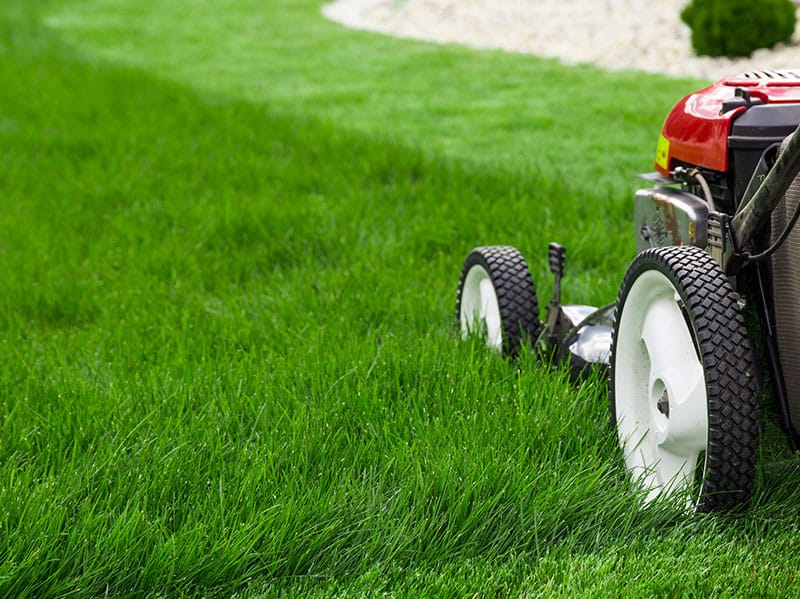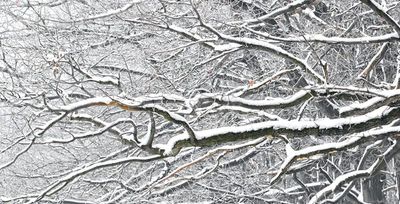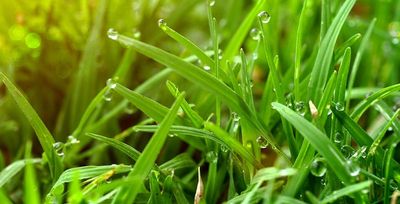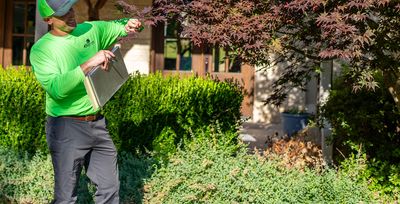How To Reduce Yard Work In The Oklahoma Heat
Just the thought of mowing the yard or weeding the flower beds this time of year is enough to make you say uuuggghhh! Hot summers should be more about spending time on swimming pool activities and backyard bar-b-ques rather than spending time on heat-exhausting yard work. What's the secret to less yard work out in the heat and enjoying more pool time? The answer is simple: a well-timed lawn maintenance plan.

Summer months are the time of year when folks should be enjoying the fruits of their labor, but how do we get there? It all boils down to good ole planning. At Nutri-Green, we spend a lot of time talking with customers helping them plan for a successful year in the yard.
Here are our three most-critical maintenance habits that will save you time out of the Oklahoma heat:
Start Early
The key to less lawn and landscape maintenance is to start early, during the months that no one thinks about the yard. Here in Oklahoma, that is early spring and fall (more on fall later.) Let's face it: yard work is far from most people's minds during the cold months of January and February, but don't let the cold weather distract you from getting ahead.
Spring pre-emergent weed control
On the lawn, starting weed control is a must. Weeds typically grow faster than most grasses, causing us to mow more often. Applying pre-emergence to the lawn and landscape creates a weed barrier, reducing the early start of mowing. By treating this time of year, you save four or five weeks of first season mowing. Having to break out the lawnmower to mow weeds when the grass hasn't turned green yet can be irritating. More on the point of mowing, when we prevent early summer weeds, the cycle of continual weed growth all summer long is disrupted; therefore, early weed control reduces mowing in the hot summer months as well.
Insecticides to protect your plants
In the landscape, it's time to start protecting landscape plants from overwintering bugs. February is a great time to take advantage of the cold temperatures by applying insecticides to plants that cannot be used during the hotter months. When you apply horticultural oil to your plants, this will smother sap-sucking insects—like scale—that can stunt plant growth. Another benefit is preventing the insect's eggs from emerging, which disrupts their life cycle and significantly reduces spring insect damage.
Fertilize your trees & shrubs
Another must-do is to apply fertilizer to your trees and shrubs to provide vital nutrients ahead of the surge of spring growth. Added nutrients supplement the plant's energy reserves for vibrant spring blooms and new growth.
The name of the game this time of year is to support desired plant growth, stop unwanted weeds, and inhibit pest activity. These landscape practices will protect your plants and reduce extra maintenance work in the upcoming hot months of summer.
Selective pruning, spring clean-up, & scalping
With weed control and landscape treatments already underway, and the threat of frost has passed, it's time to clean out the landscape beds, prune the shrubs, and remove the dead grass from the lawn.
Pruning
Pruning trees and shrubs not only shapes and improves appearance, but it also focuses on plant growth where it's most needed. It's time to spring into yard work action just before air temperatures change from cold to mild. Look for the first appearance of tree buds, colorful plants, and flower blooms to emerge, and the grass beginning to green. Any of these signs indicate the time to prune ornamentals and scalp the lawn.
Yard clean-up
When gathering deadfall and raking leaves, be gentle around plants not to pull surface roots. Mulch fades and decomposes. We recommend replacing or adding fresh mulch each year or two. Remove old mulch to set the stage for a new layer of mulch once spring planting is done. Lightly sprinkle fertilizer around plants just before you add in mulch to give them a little food. Maintain a robust 3-inch-thick mulch layer to trap moisture and reduce weed germination.
Scalping
Scalping your lawn jumpstarts the transition to spring growth. Scalping Bermuda grass is the process of mowing short and removing the dead, brown grass above the soil. Don't worry—you're not killing the grass. The dormant brown-colored grass doesn't turn green, and new grass growth emerges from the roots lying in the soil. Scalping also helps eliminate a layer of thatch that holds moisture. Unless removed in the spring, it will provide a haven for diseases in your yard.
End the year strong
Now let's skip through summer and look at fall. It's tempting to shut the gate and let Mother Nature take charge after the peak of summer blooms and the blistering heat has ended. After all, you've reaped summer's benefits, and you're ready for the hot routine maintenance to be over. Now that fall is here, what more is needed? The answer depends on how much easier you'd like things to be when spring rolls around. Similar to starting early in spring and preparing for summertime, fall yard maintenance will reduce the amount of work when spring arrives. On the lawn, it's time for fall pre-emergent applications unless you are over-seeding fescue.
Fall pre-emergent weed control
Fall pre-emergence has become more critical today than ever before. With the rise in weed varieties developing chemical resistance, treating ahead of early spring weed germination is by far the best practice.
Over-seeding
We recommend over-seeding fescue at least once or twice a year because, during the hot summer months, fescue goes dormant. It may look green and as if it's growing, but don't be fooled—its metabolism has slowed into a dormant state. This weakened state causes the grass to thin, introduces weeds, and causes grass loss. Over-seeding each year will add a new generation of grass and keep the lawn thick.
Grass height
Leave the Bermuda and Zoysia grass tall as it transitions into dormancy—this extra height insulates the soil, which will reduce the chances of winter killing the plant (“winter-kill”) if a harsh winter blows in.
Tree & shrub fertilization & oil application
For the landscape, it's simple: apply dormant oil to trees and shrubs to prevent or kill scale, and apply a deep-root, well-balanced fertilizer. Neglecting fall fertilizer to trees and shrubs seems to be a common practice for folks who haven't purchased our Plant Health Care program. Beneath the soil, root systems develop multiple tiny fibrous roots that absorb water and nutrients. By supplying fertilizer to the roots, you'll provide nutrients where it's needed most. Fall nutrients help replace depleted energy used up during the summer and prepare your trees and shrubs for the next growing season.
A warning for DIY lawn care & landscaping
Although Nutri-Green supports do-it-yourselfers, here is a word of caution. There are a variety of factors to consider that are often overlooked when choosing DIY lawn and landscaping care. There is no doubt that DIY will save time and money, but we don't want you to get stuck with "DIY fail" that you could've avoided. Before choosing to do-it-yourself, here is some helpful advice to consider.
Time investment
Landscaping can be a big-time commitment. It takes months, if not years, to achieve the way you want your yard to look. Overextended family schedules are typical these days, leaving little extra time to spend out in the yard, so adding in landscaping chores could take up more time than you have available.
Plant knowledge
The amount of knowledge you must have is one of the biggest cons against DIY lawn and landscape care. There are hundreds of varieties of plants, grass types, and other factors to consider when it comes to successfully maintaining a beautiful lawn. It can be hard to identify problems that occur and care for some plants correctly. Knowing what to do when a sudden weather change occurs requires different maintenance adjustments that you may not be aware of. Choosing the right kind of plants and routine maintenance know-how can be an overwhelming experience.
There are both pros and cons to choosing DIY lawn care and landscaping. Every homeowner will have different experiences and choices to make when it comes to deciding how to take care of their lawn and landscaping. If you implement these practices at the proper time of year and hand over weed control and plant health care to Nutri-Green, our partnership with you will significantly reduce the maintenance time you'll spend in the heat of summer. Let's face it: extra yard work in the Oklahoma heat can be challenging and brutal. If you would like to reduce the amount of work meeting you next summer, consider some of these suggestions along with our services, and spend more time out of the heat, enjoying the things you love.

Testimonials



News, Blogs & Articles
Our Blog











